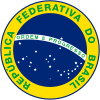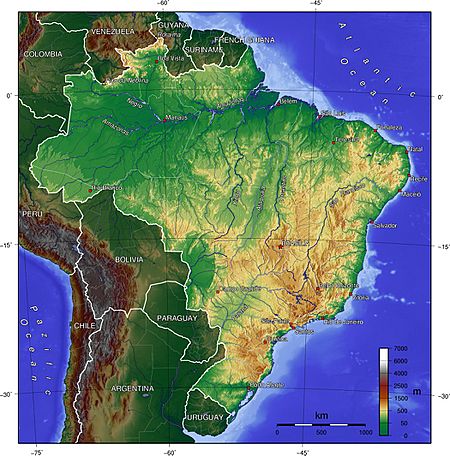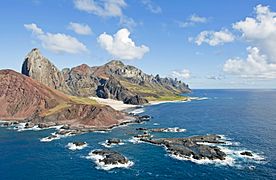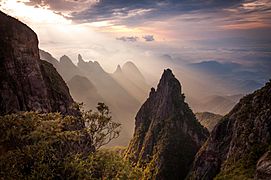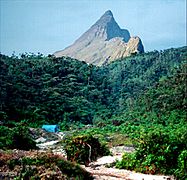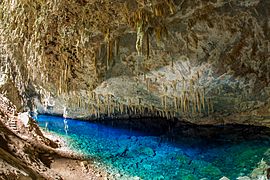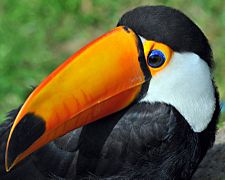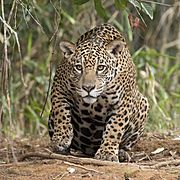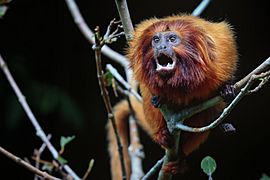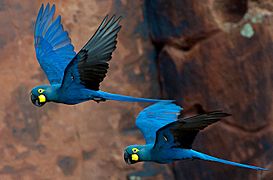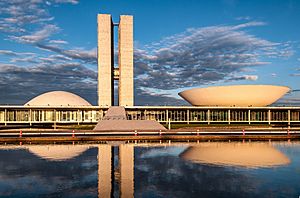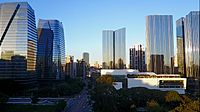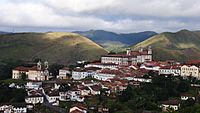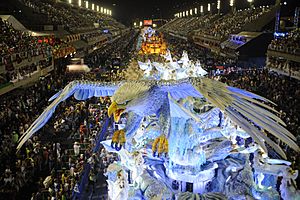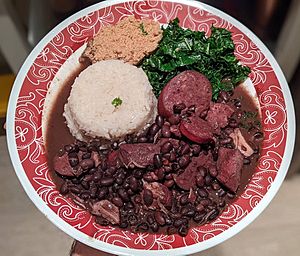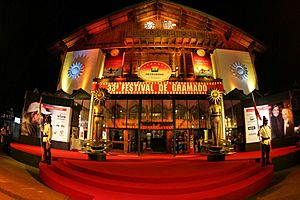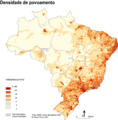Brazil facts for kids
Quick facts for kids
Federative Republic of Brazil
República Federativa do Brasil (Portuguese)
|
|
|---|---|
|
Motto: Ordem e Progresso (Portuguese)
"Order and Progress" |
|
|
Anthem: Hino Nacional Brasileiro (Portuguese)
"Brazilian National Anthem" Flag anthem: Hino à Bandeira Nacional (Portuguese)
"National Flag Anthem" |
|
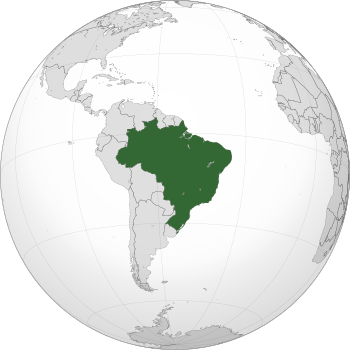 |
|
| Capital | Brasília 15°47′S 47°52′W / 15.783°S 47.867°W |
| Largest city | São Paulo 23°33′S 46°38′W / 23.550°S 46.633°W |
| Official language and national language |
Portuguese |
| Recognized regional languages | 21 languages |
| Ethnic groups
(2022)
|
|
| Religion
(2010)
|
|
| Demonym(s) | Brazilian |
| Government | Federal presidential republic |
| Lula da Silva | |
| Geraldo Alckmin | |
| Arthur Lira | |
| Legislature | National Congress |
| Federal Senate | |
| Chamber of Deputies | |
| Independence
from Portugal
|
|
|
• Declared
|
7 September 1822 |
|
• Recognized
|
29 August 1825 |
|
• Republic
|
15 November 1889 |
|
• Current constitution
|
5 October 1988 |
| Area | |
|
• Total
|
8,515,767 km2 (3,287,956 sq mi) (5th) |
|
• Water (%)
|
0.65 |
| Population | |
|
• 2022 census
|
|
|
• Density
|
25/km2 (64.7/sq mi) (193rd) |
| GDP (PPP) | 2023 estimate |
|
• Total
|
|
|
• Per capita
|
|
| GDP (nominal) | 2023 estimate |
|
• Total
|
|
|
• Per capita
|
|
| Gini (2020) | ▼ 48.9 high |
| HDI (2022) | high · 87th |
| Currency | Real (R$) (BRL) |
| Time zone | UTC−2 to −5 (BRT) |
| DST is not observed. | |
| Date format | dd/mm/yyyy (CE) |
| Driving side | right |
| Calling code | +55 |
| ISO 3166 code | BR |
| Internet TLD | .br |
Brazil (officially called Federative Republic of Brazil) is a country in South America. It is the world's fifth largest country. The country has about 209 million people. The capital of Brazil is Brasília.
Contents
History
The first people to come to Brazil came around 9,000 B.C. That group of people is often called the South American Indians. They probably came from North America. Some of them were hunters and gatherers, but others were farmers.
Pedro Álvares Cabral was the first European to see Brazil. He saw it in 1500. He was from Portugal and the Portuguese government claimed Brazil. Soon, explorers explored the whole coastline of Brazil and colonies were set up. In the late 1500s and early 1600s the Dutch and the French would sometimes try to take land in Brazil. Brazilians started moving inland farther than the Treaty of Tordesillas said they could. This caused some fights with the Spaniards and native people in the area.
In 1822, Brazil claimed to be its own country and not a part of Portugal anymore. Soon there was civil war. But the emperor Pedro II improved the economy, and in 1888, he freed the slaves. In 1889, there was a military coup and Pedro II had to leave the country.
In 1889, Brazil became a republic. It was not very democratic, because the only people who could vote were people who owned land. There were some uprisings in the 1920s because some people thought the government was unfairly helping coffee growers. Brazil joined the Allies during World War II.
During the 1960s, the leader Castelo Branco made the government like a dictatorship. Since then, the country has become more democratic, but some people feel that there are still big problems in health and education.
In September 2016, then-president Dilma Rousseff was removed from office because of impeachment.
Languages
Most people in Brazil speak Portuguese. Brazil is the only country in Latin America that speaks Portuguese.
Some people in Brazil speak German dialects. That came from German immigrants. 0.8% of Brazilians speak German as their first language.
Other people in Brazil speak indigenous Brazilian languages, Italian, Japanese, French, or Spanish. Guaraní and Aymará are the first languages of a small number of Brazilians.
Geography
Brazil occupies a large area along the eastern coast of South America and includes much of the continent's interior, sharing land borders with Uruguay to the south; Argentina and Paraguay to the southwest; Bolivia and Peru to the west; Colombia to the northwest; and Venezuela, Guyana, Suriname and France (French overseas region of French Guiana) to the north. It shares a border with every South American country except Ecuador and Chile. It also encompasses a number of oceanic archipelagos, such as Fernando de Noronha, Rocas Atoll, Saint Peter and Paul Rocks, and Trindade and Martim Vaz. Its size, relief, climate, and natural resources make Brazil geographically diverse. Including its Atlantic islands, Brazil lies between latitudes 6°N and 34°S, and longitudes 28° and 74°W.
Brazil is the fifth largest country in the world, and third largest in the Americas, with a total area of 8,515,767.049 km2 (3,287,956 sq mi), including 55,455 km2 (21,411 sq mi) of water. It spans four time zones; from UTC−5 comprising the state of Acre and the westernmost portion of Amazonas, to UTC−4 in the western states, to UTC−3 in the eastern states (the national time) and UTC−2 in the Atlantic islands.
Brazil is the only country in the world that has the equator and the Tropic of Capricorn running through it. It is also the only country to have contiguous territory both inside and outside the tropics. Brazilian topography is also diverse and includes hills, mountains, plains, highlands, and scrublands. Much of the terrain lies between 200 metres (660 ft) and 800 metres (2,600 ft) in elevation. The main upland area occupies most of the southern half of the country. The northwestern parts of the plateau consist of broad, rolling terrain broken by low, rounded hills.
The southeastern section is more rugged, with a complex mass of ridges and mountain ranges reaching elevations of up to 1,200 metres (3,900 ft). These ranges include the Mantiqueira and Espinhaço mountains and the Serra do Mar. In the north, the Guiana Highlands form a major drainage divide, separating rivers that flow south into the Amazon Basin from rivers that empty into the Orinoco River system, in Venezuela, to the north. The highest point in Brazil is the Pico da Neblina at 2,994 metres (9,823 ft), and the lowest is the Atlantic Ocean.
Brazil has a dense and complex system of rivers, one of the world's most extensive, with eight major drainage basins, all of which drain into the Atlantic. Major rivers include the Amazon (the world's second-longest river and the largest in terms of volume of water), the Paraná and its major tributary the Iguaçu (which includes the Iguazu Falls), the Negro, São Francisco, Xingu, Madeira and Tapajós rivers.
- Geography of Brazil
-
Trindade and Martin Vaz is a volcanic archipelago off the coast of the Brazil.
-
Serra dos Órgãos, part of the Serra do Mar.
-
Chapada Diamantina, in the Chapada Diamantina National Park, Bahia.
-
Iguazu Falls, Paraná, is the largest waterfalls system in the world.
-
Pico da Neblina, Amazonas, the highest mountain in Brazil.
-
Cavern in Bonito, Mato Grosso do Sul.
Climate
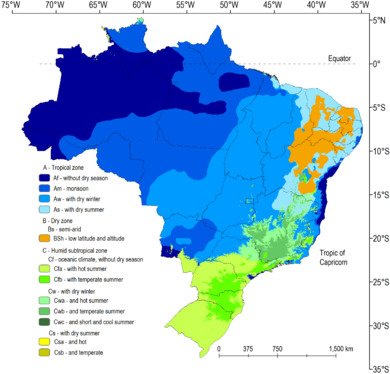
The climate of Brazil comprises a wide range of weather conditions across a large area and varied topography, but most of the country is tropical. According to the Köppen system, Brazil hosts six major climatic subtypes: desert, equatorial, tropical, semiarid, oceanic and subtropical. The different climatic conditions produce environments ranging from equatorial rainforests in the north and semiarid deserts in the northeast, to temperate coniferous forests in the south and tropical savannas in central Brazil. Many regions have starkly different microclimates.
An equatorial climate characterizes much of northern Brazil. There is no real dry season, but there are some variations in the period of the year when most rain falls. Temperatures average 25 °C (77 °F), with more significant temperature variation between night and day than between seasons.
Over central Brazil rainfall is more seasonal, characteristic of a savanna climate. This region is as extensive as the Amazon basin but has a very different climate as it lies farther south at a higher altitude. In the interior northeast, seasonal rainfall is even more extreme. The semiarid climatic region generally receives less than 800 millimetres (31.5 in) of rain, most of which generally falls in a period of three to five months of the year and occasionally less than this, creating long periods of drought. Brazil's 1877–78 Grande Seca (Great Drought), the worst in Brazil's history, caused approximately half a million deaths. A similarly devastating drought occurred in 1915.
South of Bahia, near the coasts, and more southerly most of the state of São Paulo, the distribution of rainfall changes, with rain falling throughout the year. The south enjoys subtropical conditions, with cool winters and average annual temperatures not exceeding 18 °C (64.4 °F); winter frosts and snowfall are not rare in the highest areas.
Biodiversity and environment
Brazil's large territory comprises different ecosystems, such as the Amazon rainforest, recognized as having the greatest biological diversity in the world, with the Atlantic Forest and the Cerrado, sustaining the greatest biodiversity. In the south, the Araucaria pine forest grows under temperate conditions. The rich wildlife of Brazil reflects the variety of natural habitats. Scientists estimate that the total number of plant and animal species in Brazil could approach four million, mostly invertebrates.
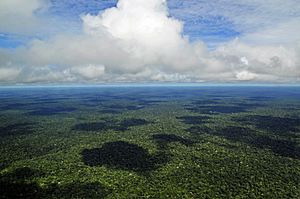
Larger mammals include carnivores pumas, jaguars, ocelots, rare bush dogs, and foxes, and herbivores peccaries, tapirs, anteaters, sloths, opossums, and armadillos. Deer are plentiful in the south, and many species of New World monkeys are found in the northern rain forests. Concern for the environment has grown in response to global interest in environmental issues. Brazil's Amazon Basin is home to an extremely diverse array of fish species, including the red-bellied piranha. Despite its reputation as a ferocious freshwater fish, the red-bellied piranha is actually a generally timid scavenger. Biodiversity can contribute to agriculture, livestock, forestry and fisheries extraction. However, almost all economically exploited species of plants, such as soybeans and coffee, or animals, such as chickens, are imported from other countries, and the economic use of native species still crawls. In the Brazilian GDP, the forest sector represents just over 1% and fishing 0.4%.
The natural heritage of Brazil is severely threatened by cattle ranching and agriculture, logging, mining, resettlement, oil and gas extraction, over-fishing, wildlife trade, dams and infrastructure, water pollution, climate change, fire, and invasive species. In many areas of the country, the natural environment is threatened by development. Construction of highways has opened up previously remote areas for agriculture and settlement; dams have flooded valleys and inundated wildlife habitats; and mines have scarred and polluted the landscape. At least 70 dams are said to be planned for the Amazon region, including the controversial Belo Monte hydroelectric dam.
- Biodiversity of Brazil
-
Toco toucan, a Brazilian symbol, a country with one of the largest variety of birds in the world.
-
Female pantanal jaguar in Piquirí River, Pantanal.
-
Golden lion tamarin, an endemic animal of Brazil, in the Poço das Antas Biological Reserve.
Government and politics
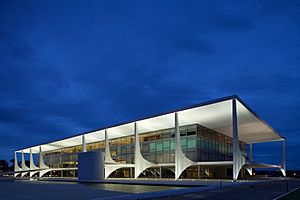
The form of government is a democratic federative republic, with a presidential system. The president is both head of state and head of government of the Union and is elected for a four-year term, with the possibility of re-election for a second successive term. The President appoints the Ministers of State, who assist in government.
Legislative houses in each political entity are the main source of law in Brazil. The National Congress is the Federation's bicameral legislature, consisting of the Chamber of Deputies and the Federal Senate. Judiciary authorities exercise jurisdictional duties almost exclusively. In 2021, the Economist Intelligence Unit's Democracy Index categorized Brazil as a "flawed democracy", ranking 46th in the report, and Freedom House classified it as a free country at Freedom in the World report.
The political-administrative organization of the Federative Republic of Brazil comprises the Union, the states, the Federal District, and the municipalities. The Union, the states, the Federal District, and the municipalities, are the "spheres of government". The federation is set on five fundamental principles: sovereignty, citizenship, dignity of human beings, the social values of labor and freedom of enterprise, and political pluralism.
The classic tripartite branches of government (executive, legislative and judicial under a checks and balances system) are formally established by the Constitution. The executive and legislative are organized independently in all three spheres of government, while the judiciary is organized only at the federal and state and Federal District spheres. All members of the executive and legislative branches are directly elected.
For most of its democratic history, Brazil has had a multi-party system, with proportional representation. Voting is compulsory for the literate between 18 and 70 years old and optional for illiterates and those between 16 and 18 or beyond 70. The country has more than 40 active political parties. Fifteen political parties are represented in Congress. It is common for politicians to switch parties, and thus the proportion of congressional seats held by particular parties changes regularly.
Economy
Brazil is the largest national economy in Latin America, the world's ninth largest economy and the eighth largest in purchasing power parity (PPP) according to 2018 estimates. Brazil has a mixed economy with abundant natural resources.
The country has been expanding its presence in international financial and commodities markets, and is one of a group of four emerging economies called the BRIC countries. Brazil has been the world's largest producer of coffee for the last 150 years. The country is a major exporter of soy, iron ore, pulp (cellulose), maize, beef, chicken meat, soybean meal, sugar, coffee, tobacco, cotton, orange juice, footwear, airplanes, cars, vehicle parts, gold, ethanol, semi-finished iron, among other products.
Tourism
Tourism in Brazil is a growing sector and key to the economy of several regions of the country. In the list of world tourist destinations, in 2018, Brazil was the 48th most visited country, with 6.6 million tourists (and revenues of 5.9 billion dollars).
Natural areas are its most popular tourism product, a combination of ecotourism with leisure and recreation, mainly sun and beach, and adventure travel, as well as cultural tourism. Among the most popular destinations are the Amazon Rainforest, beaches and dunes in the Northeast Region, the Pantanal in the Center-West Region, beaches at Rio de Janeiro and Santa Catarina, cultural tourism in Minas Gerais and business trips to São Paulo.
Culture
The core culture of Brazil is derived from Portuguese culture, because of its strong colonial ties with the Portuguese Empire. Among other influences, the Portuguese introduced the Portuguese language, Roman Catholicism and colonial architectural styles. The culture was also strongly influenced by African, indigenous and non-Portuguese European cultures and traditions.
Some aspects of Brazilian culture were influenced by the contributions of Italian, German and other European as well as Japanese, Jewish and Arab immigrants who arrived in large numbers in the South and Southeast of Brazil during the 19th and 20th centuries. The indigenous Amerindians influenced Brazil's language and cuisine; and the Africans influenced language, cuisine, music, dance and religion.
Brazilian art has developed since the 16th century into different styles that range from Baroque (the dominant style in Brazil until the early 19th century) to Romanticism, Modernism, Expressionism, Cubism, Surrealism and Abstractionism. Brazilian cinema dates back to the birth of the medium in the late 19th century and has gained a new level of international acclaim since the 1960s.
Architecture
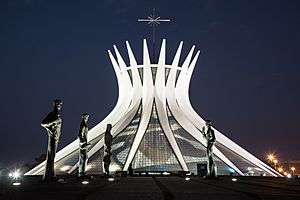
The architecture of Brazil is influenced by Europe, especially Portugal. It has a history that goes back 500 years to the time when Pedro Álvares Cabral landed in Brazil in 1500. Portuguese colonial architecture was the first wave of architecture to go to Brazil. It is the basis for all Brazilian architecture of later centuries. In the 19th century during the time of the Empire of Brazil, the country followed European trends and adopted Neoclassical and Gothic Revival architecture. Then in the 20th century especially in Brasilia, Brazil experimented with Modernist architecture.
The colonial architecture of Brazil dates to the early 16th century when Brazil was first explored, conquered and settled by the Portuguese. The Portuguese built architecture familiar to them in Europe in their aim to colonize Brazil. They built Portuguese colonial architecture which included churches, civic architecture including houses and forts in Brazilian cities and the countryside.
During 19th century, Brazilian architecture saw the introduction of more European styles to Brazil such as Neoclassical and Gothic Revival architecture. This was usually mixed with Brazilian influences from their own heritage which produced a unique form of Brazilian architecture.
In the 1950s, the modernist architecture was introduced when Brasilia was built as new federal capital in the interior of Brazil to help develop the interior. The architect Oscar Niemeyer idealized and built government buildings, churches and civic buildings in the modernist style.
Music
The music of Brazil was formed mainly from the fusion of European, Native Indigenous, and African elements. Until the nineteenth century, Portugal was the gateway to most of the influences that built Brazilian music, although many of these elements were not of Portuguese origin, but generally European. The first was José Maurício Nunes Garcia, author of sacred pieces with influence of Viennese classicism. The major contribution of the African element was the rhythmic diversity and some dances and instruments that had a bigger role in the development of popular music and folk, flourishing especially in the twentieth century.
Popular music since the late eighteenth century began to show signs of forming a characteristically Brazilian sound, with samba considered the most typical and on the UNESCO cultural heritage list. Maracatu and Afoxê are two music traditions that have been popularized by their appearance in the annual Brazilian Carnivals. Capoeira is usually played with its own music referred to as capoeira music, which is usually considered to be a call-and-response type of folk music. Forró is a type of folk music prominent during the Festa Junina in northeastern Brazil. Jack A. Draper III, a professor of Portuguese at the University of Missouri, argues that Forró was used as a way to subdue feelings of nostalgia for a rural lifestyle.
Choro is a very popular music instrumental style. Its origins are in 19th-century Rio de Janeiro. In spite of the name, the style often has a fast and happy rhythm, characterized by virtuosity, improvisation, subtle modulations and full of syncopation and counterpoint. Bossa nova is also a well-known style of Brazilian music developed and popularized in the 1950s and 1960s. The phrase "bossa nova" means literally "new trend". A lyrical fusion of samba and jazz, bossa nova acquired a large following starting in the 1960s.
Literature
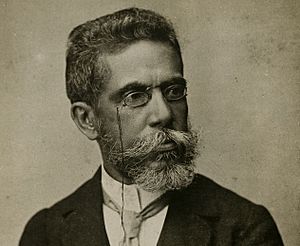
Brazilian literature dates back to the 16th century, to the writings of the first Portuguese explorers in Brazil, such as Pêro Vaz de Caminha, filled with descriptions of fauna, flora and commentary about the indigenous population that fascinated European readers.
Brazil produced significant works in Romanticism – novelists like Joaquim Manuel de Macedo and José de Alencar wrote novels about love and pain. Alencar, in his long career, also treated indigenous people as heroes in the Indigenist novels O Guaraní, Iracema and Ubirajara. Machado de Assis, one of his contemporaries, wrote in virtually all genres and continues to gain international prestige from critics worldwide.
Brazilian Modernism, evidenced by the Modern Art Week in 1922, was concerned with a nationalist avant-garde literature, while Post-Modernism brought a generation of distinct poets like João Cabral de Melo Neto, Carlos Drummond de Andrade, Vinicius de Moraes, Cora Coralina, Graciliano Ramos, Cecília Meireles, and internationally known writers dealing with universal and regional subjects like Jorge Amado, João Guimarães Rosa, Clarice Lispector and Manuel Bandeira.
Brazil's most significant literary award is the Camões Prize, which it shares with the rest of the Portuguese-speaking world. As of 2016, Brazil has eleven recipients of the prize. Brazil also holds its own literary academy, the Brazilian Academy of Letters, a non-profit cultural organization pointed in perpetuating the care of the national language and literature.
Cuisine
Brazilian cuisine varies greatly by region, reflecting the country's varying mix of indigenous and immigrant populations. This has created a national cuisine marked by the preservation of regional differences. Examples are Feijoada, considered the country's national dish; and regional foods such as beiju, feijão tropeiro, vatapá, moqueca, polenta (from Italian cuisine) and acarajé (from African cuisine).
The national beverage is coffee and cachaça is Brazil's native liquor. Cachaça is distilled from sugar cane and is the main ingredient in the national cocktail, Caipirinha.
The basis of Brazilian daily cuisine is the starch (most often a cereal), legume, protein and vegetable combination. There is also a differentiation between vegetables of the verduras group, or greens, and the legumes group (no relation to the botanic concept), or non-green vegetables.
A typical meal consists mostly of rice and beans with beef, salad, french fries and a fried egg. Often, it is mixed with cassava flour (farofa). Fried potatoes, fried cassava, fried banana, fried meat and fried cheese are very often eaten in lunch and served in most typical restaurants. Popular snacks are pastel (a fried pastry); coxinha (a variation of chicken croquete); pão de queijo (cheese bread and cassava flour / tapioca); pamonha (corn and milk paste); esfirra (a variation of Lebanese pastry); kibbeh (from Arabic cuisine); empanada (pastry) and empada, little salt pies filled with shrimps or heart of palm.
Brazil has a variety of desserts such as brigadeiros (chocolate fudge balls), bolo de rolo (roll cake with goiabada), cocada (a coconut sweet), beijinhos (coconut truffles and clove) and Romeu e Julieta (cheese with goiabada). Peanuts are used to make paçoca, rapadura and pé-de-moleque. Local common fruits like açaí, cupuaçu, mango, papaya, cocoa, cashew, guava, orange, lime, passionfruit, pineapple, and hog plum are turned in juices and used to make chocolates, ice pops and ice cream.
Brazilian cuisine is recognized around the world for its variety and quality. The city of São Paulo was chosen as the 7th main gastronomic destination in the world, for its recognized restaurants and bars. This Brazilian city comes after Rome, London, Paris, Dubai, Barcelona and Madrid. The city of São Paulo alone has more than 9,000 restaurants and bars.
Popular dishes
- Churrasco is the main dish of southern Brazil. Over time, other regions of Brazil adopted churrasco and created other ways of making it. The restaurant specializing in churrasco is a churrascaria.
- Virado, typical dish from the state of São Paulo, where it is also known as Virado à Paulista, which consists of a pork chop, fried plantain, cassava flour beans, rice, cabbage and fried egg.
- Tutu de feijão, typical dish from the state of Minas Gerais, made with boiled beans, sautéed and thickened with cassava or corn flour. It is usually sautéed with pieces of fried bacon, onion and garlic, and mixed with cassava flour or corn flour depending on the type of bean.
- Arroz carreteiro is a typical dish from the southern region of Brazil, made from rice to which is added finely chopped and sautéed beef, shredded or minced dried meat or sun-dried meat, sometimes paio, bacon and chorizo. in pieces, sautéed in a lot of fat, with garlic, onion, tomato and parsley, always with a lot of seasoning.
- Galinhada is a typical dish from the states of São Paulo, Minas Gerais and Goiás, which consists of cooked rice and cooked chicken pieces. The seasoning is composed of saffron (which gives the rice the typical yellowish color), vinaigrette (optional and to accompany), and bean tutu. The typical Goiás chicken dish contains guariroba (a type of bitter palm) and pequi.
- Barreado is a typical dish of Parana State, Brazil. It is a slow-cooked meat stew prepared in a clay pot whose lid is sealed with a sort of clay made from wheat or cassava flour, hence the name (which means, literally, "muddied"). Traditionally, Barreado was made of buffalo meat, but nowadays it is usually made of beef, bacon, tomatoes, onion, cumin and other spices, placed in successive layers in a large clay urn, covered and then "barreada" (sealed) with a paste of ash and farinha (manioc flour), and then slowly cooked in a wood-fired oven for 12 to 18 hours. Nowadays pressure cookers and gas or electric ovens are more commonly used.
- Cachorro quente is the Brazilian version of hot dogs. It is another dish that has been modified in Brazil, practically becoming a complete lunch. There, the most common version is the "X-Tudo" (in literal translation, cheese-everything), or "Podrão", where, in addition to conventional bread and sausages with ketchup, mustard and mayonnaise, it is filled with a series of additional ingredients ranging from straw fries, grated Parmesan cheese, corn kernels, peas and olives to quail eggs.
- Misto-quente is grilled ham and cheese sandwich.
- Angu is a popular side dish (or a substitution for rice replacing the "starch element" and it is commonly used in Southern and Southeastern Brazil). It is similar to the Italian polenta.
- Arroz com pequi is a traditional dish from the Brazilian Cerrado, and the symbol of Center-Western Brazil's cuisine. It is basically made with rice seasoned on pequi, also known as a souari nut, and often chicken.
- Cuscuz branco is a dessert consisting of milled tapioca cooked with coconut milk and sugar and is the couscous equivalent of rice pudding.
Cinema
The Brazilian film industry began in the late 19th century, during the early days of the Belle Époque. While there were national film productions during the early 20th century, American films such as Rio the Magnificent were made in Rio de Janeiro to promote tourism in the city. The films Limite (1931) and Ganga Bruta (1933), the latter being produced by Adhemar Gonzaga through the prolific studio Cinédia, were poorly received at release and failed at the box office, but are acclaimed nowadays and placed among the finest Brazilian films of all time. The 1941 unfinished film It's All True was divided in four segments, two of which were filmed in Brazil and directed by Orson Welles; it was originally produced as part of the United States' Good Neighbor Policy during Getúlio Vargas' Estado Novo government.
During the 1960s, the Cinema Novo movement rose to prominence with directors such as Glauber Rocha, Nelson Pereira dos Santos, Paulo Cesar Saraceni and Arnaldo Jabor. Rocha's films Deus e o Diabo na Terra do Sol (1964) and Terra em Transe (1967) are considered to be some of the greatest and most influential in Brazilian film history.
During the 1990s, Brazil saw a surge of critical and commercial success with films such as O Quatrilho (Fábio Barreto, 1995), O Que É Isso, Companheiro? (Bruno Barreto, 1997) and Central do Brasil (Walter Salles, 1998), all of which were nominated for the Academy Award for Best Foreign Language Film, the latter receiving a Best Actress nomination for Fernanda Montenegro. The 2002 crime film City of God, directed by Fernando Meirelles, was critically acclaimed, scoring 90% on Rotten Tomatoes, being placed in Roger Ebert's Best Films of the Decade list and receiving four Academy Award nominations in 2004, including Best Director. Notable film festivals in Brazil include the São Paulo and Rio de Janeiro International Film Festivals and the Gramado Festival.
Visual arts
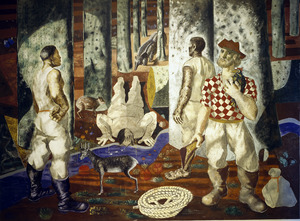
Brazilian painting emerged in the late 16th century, influenced by Baroque, Rococo, Neoclassicism, Romanticism, Realism, Modernism, Expressionism, Surrealism, Cubism and Abstracionism making it a major art style called Brazilian academic art.
The French Artistic Mission arrived in Brazil in 1816 proposing the creation of an art academy modeled after the respected Académie des Beaux-Arts, with graduation courses both for artists and craftsmen for activities such as modeling, decorating, carpentry and others and bringing artists like Jean-Baptiste Debret.
Upon the creation of the Imperial Academy of Fine Arts, new artistic movements spread across the country during the 19th century and later the event called Modern Art Week definitely broke with academic tradition in 1922 and started a nationalist trend which was influenced by modernist arts.
Among the best-known Brazilian painters are Ricardo do Pilar and Manuel da Costa Ataíde (baroque and rococo), Victor Meirelles, Pedro Américo and Almeida Júnior (romanticism and realism), Anita Malfatti, Ismael Nery, Lasar Segall, Emiliano di Cavalcanti, Vicente do Rego Monteiro, and Tarsila do Amaral (expressionism, surrealism and cubism), Aldo Bonadei, José Pancetti and Cândido Portinari (modernism).
Sports
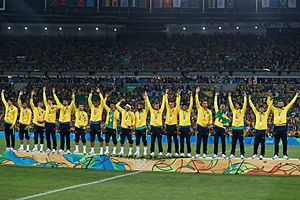
The most popular sport in Brazil is football.
Volleyball, basketball, auto racing, and martial arts also attract large audiences. The Brazil men's national volleyball team, for example, currently holds the titles of the World League, World Grand Champions Cup, World Championship and the World Cup. In auto racing, three Brazilian drivers have won the Formula One world championship eight times. The country has also produced significant achievements in other sports such as sailing, swimming, tennis, surfing, skateboarding, MMA, gymnastics, boxing, judo, athletics and table tennis.
Some sport variations have their origins in Brazil: beach football, futsal (indoor football) and footvolley emerged in Brazil as variations of football. In martial arts, Brazilians developed Capoeira, Vale tudo, and Brazilian jiu-jitsu.
Brazil has hosted several high-profile international sporting events, like the 1950 FIFA World Cup and recently has hosted the 2014 FIFA World Cup, 2019 Copa América and 2021 Copa América . The São Paulo circuit, Autódromo José Carlos Pace, hosts the annual Grand Prix of Brazil. São Paulo organized the IV Pan American Games in 1963, and Rio de Janeiro hosted the XV Pan American Games in 2007. On 2 October 2009, Rio de Janeiro was selected to host the 2016 Olympic Games and 2016 Paralympic Games, making it the first South American city to host the games and second in Latin America, after Mexico City. Furthermore, the country hosted the FIBA Basketball World Cups in 1954 and 1963. At the 1963 event, the Brazil national basketball team won one of its two world championship titles.
Interesting facts about Brazil
- Brazil is the largest country in South America.
- It is the only Portuguese-speaking nation in the Americas.
- Brazil was named after brazilwood. Brazilwood is a tree that once grew very well along the Brazilian coast.
- The Brazilian men's national team is ranked among the best in the world according to the FIFA World Rankings, and has won the World Cup tournament a record five times.
- Brazil has the largest Japanese community outside Japan.
Images for kids
-
Depiction of Pedro Álvares Cabral landing in Porto Seguro in 1500, ushering in more than 300 years of Portuguese rule of Colonial Brazil.
-
The Acclamation of King João VI of the United Kingdom of Portugal, Brazil and the Algarves in Rio de Janeiro, 6 February 1818
-
Declaration of the Brazilian independence by Prince Pedro (later Emperor Pedro I) on 7 September 1822.
-
Pedro II, Emperor of Brazil between 1831 and 1889.
-
Soldiers of the FEB, the only Latin American military force in World War II, in Massarosa, Italy, 1944.
-
Ulysses Guimarães holding the Constitution of 1988 in his hands
-
Historical building of the Federal University of Paraná, one of the oldest universities in Brazil, located in Curitiba.
-
Former President Dilma Rousseff at Jornal Nacional news program. Rede Globo is the world's second-largest commercial television network.
-
Museum of the Portuguese Language in São Paulo
-
In the region of Pomerode, Santa Catarina, Hunsrückisch and East Pomeranian are two of the minor languages (see Brazilian German).
-
Parade of Portela samba school at the Rio Carnival, the largest carnival in the world
-
The Cathedral of Brasilia, designed by Brazilian architect Oscar Niemeyer for the federal capital, an example of Modern architecture
See also
 In Spanish: Brasil para niños
In Spanish: Brasil para niños




